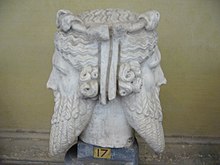User:Toad Person/Temple of Janus (Roman Forum)
Temple of Janus (Roman Forum)[edit][edit]
The Temple of Janus stood in the Roman Forum near the Basilica Aemilia, along the Argiletum. It was a small temple with a statue of Janus, the two-faced god of boundaries and beginnings inside. Its doors were known as the "Gates of Janus", which were closed in times of peace and opened in times of war. There are many theories about its original purpose; some say that it was a bridge over the Velabrum, and some say it functioned as a gate to the Capitoline. This article includes the origins, legends, and modern remains of the Temple of Janus in the Roman Forum.

Appearance and Construction[edit][edit]
The Temple of Janus was a small Temple just large enough to house a bronze statue of the god. While the location is given only a small portion of the surviving brick structure can be found beside the ruins of the Basilica Aemilia, along the path of the Argiletum in the Roman Forum[2] leaving the views of the temple to be illustrated by scholars and artifacts of the time period. The various styles of architecture seen on those coins suggest rough dates for the reconstructions; both in the third and fourth centuries BCE.[3] As described by the Byzantine scholar Procopius who says "the temple is entirely of bronze and was erected in the form of a square, but it is only large enough to cover the statue of Janus ... of bronze and not less than five cubits high".[3] There are also descriptions that can be taken from items from the Roman world most notably coins minted for Emperor Nero. These coins depict the Temple of Janus as a small rectangular building with two doors accompanied by two columns having Ashlar masonry on the outside and only bronze plating on the inside. This shows a discrepancy in the sources as Procopius says the Temple of Janus was made entirely of bronze whereas the coins minted by Nero show Ashlar masonry on the outside leaving the assumption to be bronze only on the inside of the Temple. The temple of Athena Chalcioecus in Sparta and Apollo at Delphi are also built this way[3].. The art style of the Temple was inspired by Etruscan and from the Near East.[3]
The Purpose of the gates of Janus[edit][edit]
The Gates themselves were the main purpose for the Temple of Janus. The opening and closing of the gates were to symbolize either wartime or peace. The Temple of Janus tied in warfare and religious tradition. It is unanimously held by ancient and modern scholars that the gates were closed in Peace and opened in times of war[4][5][6]. While its purpose is agreed upon the reasons behind the openings and closings of the gates are much murkier. Both Virgil and Ennius state that the gates held in Discord and Fury inside the temple during times of peace Ennius's Annales state "After foul Discord has broken open the iron-clad posts and gates of war"[4] Virgil supports this view with "There are twin gates of War ... Janus the guard does not withdraw from his threshold"[4]. Horace does not use prison imagery but can be interpreted as saying peace or is Janus himself is kept in the temple locked into the temple[4]. This lack of clarity by the Romans themselves demonstrates the fluctuating nature of their mythos-history. However, a Roman viewed the Temple of Janus's gates having them shut was a time of celebration and of pride for the rulers of Rome. As demonstrated by Caesar Augustus's accounts of shutting the doors three times.[7].
Bibliography[edit][edit]
- ^ dodd, Loudon. "Janus1.JPG". Wikipedia. Retrieved 12/5/2020.
{{cite web}}: Check date values in:|access-date=(help)CS1 maint: url-status (link) - ^ Coarelli, Filippo (2014-05-10). Rome and Environs. University of California Press. ISBN 978-0-520-95780-0.
- ^ a b c d Muller, Valentine (1943-10). "The Shrine of Janus Geminus in Rome". American Journal of Archaeology. 47 (4): 437. doi:10.2307/499831.
{{cite journal}}: Check date values in:|date=(help) - ^ a b c d Green, S. J. (2000). "Multiple Interpretation of the Opening and Closing of the Temple of Janus: A Misunderstanding of Ovid "Fasti" 1.281". Mnemosyne. 53 (3): 302–309. ISSN 0026-7074.
- ^ Plutarch (November 12, 2004). "Plutarch's Lives, Volume I (of 4)".
{{cite web}}: CS1 maint: url-status (link) - ^ Livy. ""The History of Rome, Vol. 1"".
{{cite web}}: CS1 maint: url-status (link) - ^ Augustus; Cooley, Alison E. (2009-05-14). "Res Gestae Divi Augusti: Text, Translation, and Commentary". Higher Education from Cambridge University Press. doi:10.1017/cbo9780511815966.004. Retrieved 2020-11-21.
